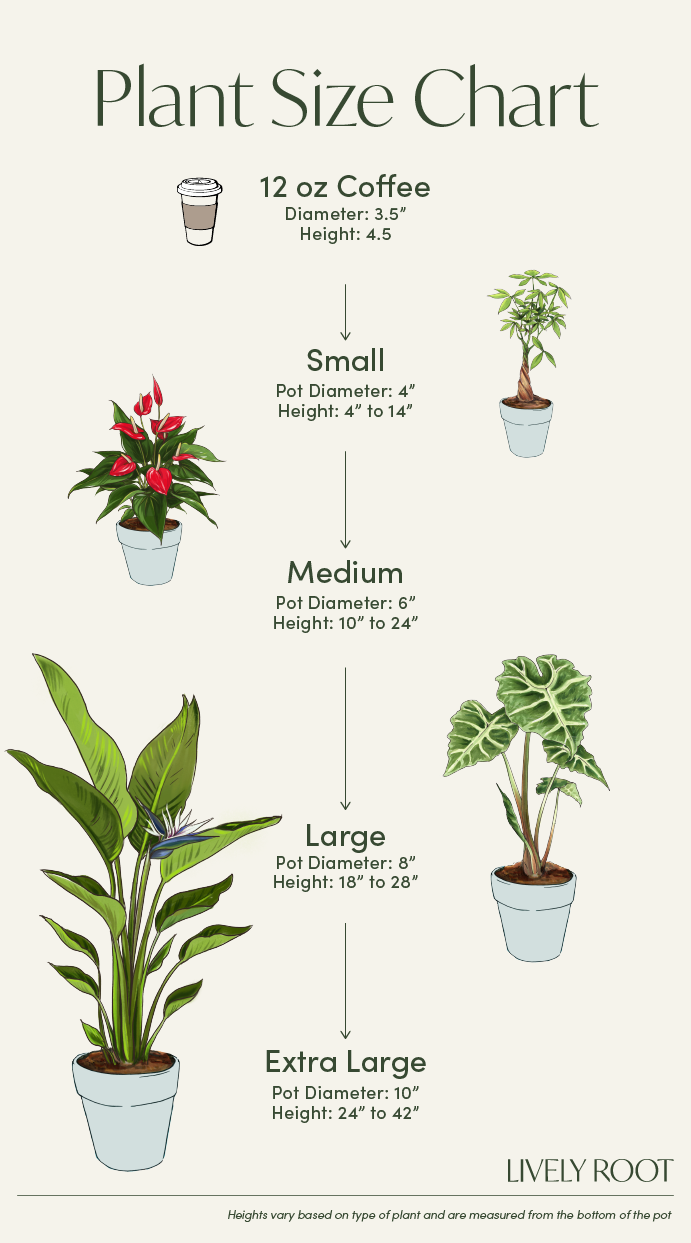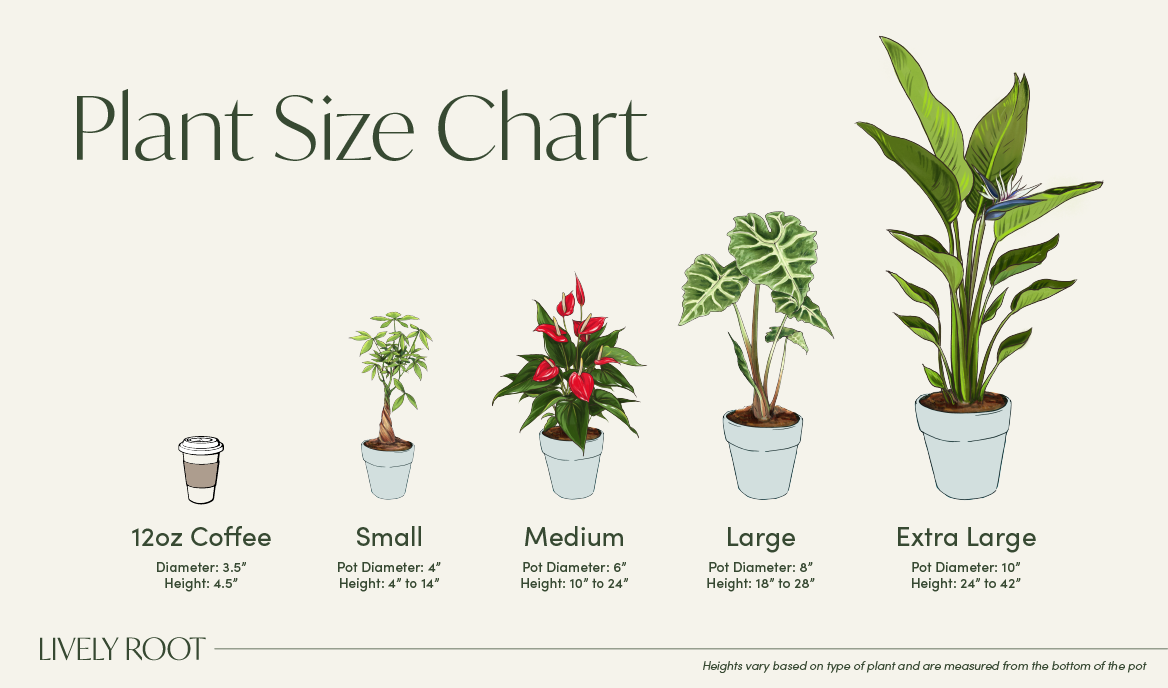

Meet the gorgeous Calathea Zebrina and enjoy both its sides! By day, the zebra-like stripes are dark green, highlighted by showy, broad, parallel chartreuse stripes that extend along the mid-vein to the leaf margins, while the undersides are reddish-purple, visible at night. This rare prayer plant is a must-have!
Calathea Zebrina Care & Buying Guide

Medium to bright indirect light. Never direct sunlight.
Keep the soil slightly moist and water when the soil reaches a #5 on the moisture meter. Use filtered, bottled, or tap water sitting 24 hours to release the chemicals and water enough to discharge out of the drainage holes. Once the water is fully drained, replace them into the cache or decorative pot. Don't let the roots sit in standing water. During winter months, water less frequently but keep it humid around the plant.
Add up to 60% humidity by adding a pebble tray filled with water, grouping with other plants or using a humidifier.
Avoid any sudden temperature changes. Keep humidity high in warmer temperatures.
Outside: Grow in morning light, partial shade (4-6 hours) where nights are above 45°F.
Indoors: The Zebra Plant prefers bright to medium, indirect light for at least six hours in a southern, eastern and western windows.
Fertilize monthly during their growing period. Use a high nitrogen liquid fertilizer at half strength to increase foliage health. Reduce during the fall and winter months while the plant is in their dormant phase. Flush the soil periodically to eliminate salts from fertilizing.
When receiving the plant, do not repot immediately but wait at least 6-12 months.
Repot in the spring, using a 2" wider pot. (Too large of a pot could cause the soil to dry slower, which is not helpful.) Use a well-draining indoor potting mix with perlite to help with drainage or an african violet potting mix.
Place a piece of screening at the bottom of the container over the drainage hole to secure the soil and allow to drain. Add soil to the bottom to elevate the root ball. Lift the plant and release the roots against the existing planter. Use a clean knife or garden trowel to wedge between the pot and the soil to loosen.
Inspect the root ball. Notice if there are any dead or rotting roots and trim off with sterile pruners. If the plant is rootbound, cut through the roots to alleviate continued encircling.
Ensure the plant is sitting about 1" below the edge of the pot to avoid water spillage. Add more soil and backfill around the sides by tamping down. Fill up to the soil line but not over.
Water thoroughly, leaving the soil damp but not soggy. If settling occurs, add more soil.
Enclose the new plantings in plastic bags, mist and keep them in medium light. Remove the plastic bag when the roots are established. You may observe some leaf changes as they acclimate to their new environment. They may suffer some transplant shock depending on how tight the roots were intertwined together. Trim off any declining leaves as they regain their energy and gets rooted into the soil over time.
Trim off any dead or damaged stems to keep energy moving to the healthy leaves. Shower the leaves using a watering can with filtered or rainwater to remove dust. Remove any debris on the soil and replenish soil if needed.
Indoors: Propagate and divide Zebra plants in the early spring when emerging from dormancy. Pull from the container and brush or wash away the soil carefully. Carefully divide and repot in a rich, indoor potting soil mix or African violet mix.
Use a container that has drainage and is deep enough for the roots to grow.
Set them in medium to bright, indirect sunlight while they are rooting. Enclose the new plantings in clear plastic bags, mist and keep them in medium light. Remove the plastic bag when the roots are established. You may observe some leaf changes as they acclimate to their new environment. They may suffer some transplant shock depending on how tight the roots were intertwined together. Trim off any declining leaves as they regain their energy and gets rooted into the soil over time. Check the moisture and humidity each day and add misting to keep the soil moist while the roots establish.
After 6-8 weeks, roots will begin to establish. You can tug onto the stem to ensure the roots are anchoring well. You can remove the clear plastic bag at this time but still maintain high humidity around the plant.
Outdoors: Carefully loosen the soil and dig the roots up and separate the plant in new locations in your garden. Add rich, damp, and loamy soil in a part-shade morning sun location. Water with filtered or rain water at soil level.
Calathea Zebrina: Overview
Calathea Zebrina (Calathea zebrina) is a gorgeous rare plant with elongated, patterned foliage, marked by a beautiful design of dark green stripes on each lime green leaf. The undersides of the leaves are red-purple, and its flowers are purple-white and cone-shaped.
This beautiful Calathea variety is a Prayer Plant and belongs to the Marantaceae family. The Calathea Zebrina plant is native to Brazil’s tropical forests; it’s most adapted to USDA hardiness zones 10-11. Calathea Zebrina can reach the size of 3 ft. in height.
Caring for Calathea Zebrina isn’t difficult, provided you maintain high humidity around this plant. It thrives in filtered sunlight that mimics its natural habitat under the canopy of tropical forests. In addition, Calathea Zebrina is not toxic to cats and dogs, like other Prayer plants.
Calathea Zebrina symbolizes new beginnings, devotion, focus on schedule, and gratitude.
Prayer Plants are known for their spectacular leaf patterns, and other beautiful Calathea plants include the delightful Peacock Plant and the silvery Calathea Setosa Compact Star.
Calathea Zebrina: Benefits
- Purifies the air
- Pet-safe plant
- Great gift plant that symbolizes new beginnings
- Reduces stress and aids relaxation
- Visually appealing foliage that adds an exotic touch to interiors
Calathea Zebrina: Care Guide
It’s easy to care for Calathea Zebrina once you know what environment it needs. Follow these simple Calathea care tips and watch your lovely indoor plant flourish:
Watering and Humidity
Water regularly to make sure that the soil remains moist but not soggy. One of the Calathea Zebrina plant care tips for healthy foliage is to use filtered or overnight water. Decrease watering in winter. Keep humidity high around this plant. Place the plant on a pebble tray, group it with other plants, or use a humidifier.
Light and Temperature
To meet Calathea Zebrina's light requirements, choose a location with plenty of moderately bright light and avoid direct sunlight. If you’re growing your plant outdoors as a porch plant, keep it in partial shade. As a tropical plant, an indoor Calathea Zebrina grows best in even, moderately warm temperatures, ranging from 60℉ to 75℉. Protect your Calathea plant from cold drafts. Outdoors, this plant requires night temperatures that remain above 45°F.
Soil and Repotting
Use a well-draining potting mix for your Calathea, and add perlite, coco coir, or pine bark to enhance moisture retention and aerate the soil at the same time. Repot your plant every two years into a slightly larger pot. Always use a pot with drainage holes to avoid overwatering your Calathea.
Feeding and Propagation
Fertilize your Calathea Zebrina monthly using a nitrogen-rich fertilizer to keep its foliage in great shape. Dilute the fertilizer by half strength and reduce feeding during winter and fall. The best way to propagate this type of Prayer plant is to divide it in the spring. You can do so when repotting your plant. Cover the new plants with a transparent plastic bag to keep humidity high around them while they form new roots.
Pruning, Cleaning, and Common Issues
Heavy pruning is not part of Calathea Zebrina care. Remove any wilting or dry leaves and stems to help your plant support its healthy leaves. Clean the dust by gently showering your plant. Brown, crisp leaves indicate low humidity, while a Calathea Zebrina with yellow leaves is likely getting overwatered. Curling leaves are common Prayer plant problems and are often a sign of exposure to changing temperatures.
Calathea Zebrina: Placement, Companion & Alternative Plants
The patterned foliage of this Calathea plant is exotic and eye-catching, making it a perfect plant to add personality to your space.
Best Locations & Uses
- Great for bedrooms and offices because it promotes relaxation and cleanses the air
- A thoughtful gift with a meaningful message
- Pet-friendly and suitable for plant lovers with cats and dogs
- Ideal for places with high humidity, like bathrooms
- An amazing porch plant for warm climates
Companion Plants
Combine your Zebrina Calathea with other vibrant plants to create a unique green corner for relaxation:
- Money Tree Plant (Pachira aquatica): Gorgeous and easy to grow, the Money Tree Plant has lovely foliage and is considered one of the best luck-bringing plants in Feng Shui.
- Cast Iron Plant (Aspidistra elatior): Known for its resilience and easy maintenance, the Cast Iron Plant is also pet-friendly and tolerant of low light.
- Spider Plant (Chlorophytum comosum): The lovely Spider Plant is an excellent air purifier, and its fountain-like foliage radiates an airy and relaxing elegance.
Alternative Plants
If you’re looking for alternative potted plants with a similar vibe, consider these:
- Maranta Red Prayer Plant ( Maranta leuconeura var. kerchoveana): Beautiful and compact with oval leaves that boast striking red variegation, the Maranta Red Prayer Plant is adorable and suitable for more experienced indoor gardeners.
- Calathea Rattlesnake (Calathea lancifolia): Another unique Calathea variety, Calathea Rattlesnake boasts a bold, vivid pattern that resembles a rattlesnake’s markings.
- Philodendron Birkin (Philodendron 'Birkin'): With its elegant striped leaf pattern, the Philodendron Birkin is a gorgeous plant with an upright growing habit that thrives in humid environments.
Order the Stunning Calathea Zebrina From Lively Root
Add tropical allure to your indoor garden with a fabulous Calathea Zebrina for sale from Lively Root!










